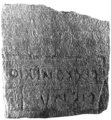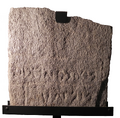VB·22
| Inscription | |
|---|---|
| Reading in transliteration: | aśkonetio / pianu |
| Reading in original script: | |
|
| |
| Object: | VB·22 Stresa (stela) |
| Position: | front |
| Orientation: | 0° |
| Frame: | |
| Direction of writing: | sinistroverse |
| Script: | North Italic script (Lepontic alphabet) |
| Letter height: | 3.5–6 cm1.378 in <br />2.362 in <br /> |
| Number of letters: | 14 |
| Number of words: | 2 |
| Number of lines: | 2 |
| Workmanship: | carved |
| Condition: | complete, damaged |
|
| |
| Archaeological culture: | La Tène D 2 [from object] |
| Date of inscription: | 1st c. BC [from object] |
|
| |
| Type: | funerary |
| Language: | Celtic |
| Meaning: | 'Pianu the Aśkonetian' (?) |
|
| |
| Alternative sigla: | Tibiletti Bruno 1981: 14 Solinas 1995: 120 Morandi 2004: 65 |
|
| |
| Sources: | Morandi 2004: 563 f. no. 65 |
Images
Commentary
First published in De Giuli 1978: 14. Examined for LexLep on 20th April 2024.
Images in De Giuli 1978: 16 (photo = De Giuli 1979: 246, fig. 1 = Mainardis 2009: 337, fig. 5) and 14 (drawing = De Giuli 1979: 246), Tibiletti Bruno 1979: 255, fig. 1 (drawing), Caramella & De Giuli 1993: 207 (drawing).
Written in two lines (length 45 cm and 27.5 cm respectively), both of which are inscribed in rectangular frames, sharing the line in between them; the frame of the shorter line (length 40 cm, height 13.5–17 cm) is shorter than that of the longer one (length 50.5 cm, height 13 cm), which covers the entire breadth of the stone, though longer than necessary for the short sequence pianu. The inscription is heavily abraded, but the letters are unambiguously legible. The alphabet is the Lepontic one; the only irregular letter shape is that of nu in both lines, which looks like Lepontic nu but with hasta and angle of the same height – the letter form seems to be a compromise between Lepontic and Latin nu, and (probably) also appears in VB·27.
The rendering and properties of the inscription as given above regard it as it is usually displayed in images and also in the museum: right-aligned sinistroverse, with aśkonetio the first and pianu the second line. According to Piana Agostinetti 2004: 199 f., however, the edge beside which the inscription is applied is the original top edge of the slab. Piana Agostinetti assumes that the lower edge, today max. 25 cm from the inscription, is a breaking edge and the stone was a stela like the other stones from the Stresa area. If the stone thus stood upright, the inscription is upside-down. Since a similar situation is found on two other Stresa stones (VB·23, VB·27), this cannot be put down to an error. Piana Agostinetti suggests that the inscription was intentionally written upside-down to be read "dalla divinità superna la cui sede è nel cielo" (p. 195). Two alternatives seem possible: 1. The original shape of the stone was much like the current one, and it was not put up as a stela, but laid down to cover the grave; the inscription was applied to be easily legible when standing above it. This is feasible also for VB·23; see VB·27 for considerations about that monument. 2. The inscription is not upside-down, but contains a number of inverted letters: dextroverse ![]()
![]()
![]()
![]()
![]() /
/ ![]()
![]()
![]()
![]()
![]()
![]()
![]()
![]()
![]() . Inconsistently inverted letters are notably common on the epichoric Stresa stones, whichever way the inscriptions are turned (see also VB·26). If the present inscription is read as seen on the upright stone, upsilon, alpha and epsilon, as well as pi would be inverted; if it is considered upside-down, only nu is inverted (cf. VB·26). That the inscription should indeed be read as rendered above is indicated by a Roman gravestone from Bee near Zoverallo, which has a similar shape as VB·22 Stresa and VB·23 Stresa, though less wide, and features an alphabetically Latin inscription in the same place and orientation near the straight edge of the stone. Lanza & Poletti Ecclesia 2021: 333 notably consider the oblique edge to be the original top and the straight edge to be a breaking edge – i.e. opposite to what Piana Agostinetti assumes for VB·22 Stresa – despite the fact that both appear to be worked.
. Inconsistently inverted letters are notably common on the epichoric Stresa stones, whichever way the inscriptions are turned (see also VB·26). If the present inscription is read as seen on the upright stone, upsilon, alpha and epsilon, as well as pi would be inverted; if it is considered upside-down, only nu is inverted (cf. VB·26). That the inscription should indeed be read as rendered above is indicated by a Roman gravestone from Bee near Zoverallo, which has a similar shape as VB·22 Stresa and VB·23 Stresa, though less wide, and features an alphabetically Latin inscription in the same place and orientation near the straight edge of the stone. Lanza & Poletti Ecclesia 2021: 333 notably consider the oblique edge to be the original top and the straight edge to be a breaking edge – i.e. opposite to what Piana Agostinetti assumes for VB·22 Stresa – despite the fact that both appear to be worked.
The linguistic content of the lines is not decisive with regard to their order, though it rather supports an upright reading of the inscription: pianu is more likely to be the individual name and thus written in the first line, while aśkonetio may be a patronym in -(i)i̯- (cf. VB·28 namu esopnio from nearby Levo). If the inscription is read upside-down, the name formula is inverted (cf. Tibiletti Bruno 1978c: 24 f., 1979: 253–257 (254 f.), 1981: 166 f., no. 14, Caramella & De Giuli 1993: 207, Markey & Mees 2003: 139, Morandi 2004: 564). Less likely, though not impossible is the interpretation of aśkonetio as the individual name and pianu as a patronym in -ū, as per De Hoz 1990: 323 f. and/or Lejeune 1971: 53 (see The Cisalpine Celtic Languages); thus Solinas 1995: 372, no. 120, critical Eska 1995: 43 β. The name formulae on the epichoric Stresa stones being overall heterogeneous and the names of uncertain order, the matter must be considered unresolved for now.
See the object page on the dating; VB·22 may belong to the oldest layer of gravestones from the Verbano.
Bibliography
| Caramella & De Giuli 1993 | Pierangelo Caramella, Alberto De Giuli, Archeologia dell'Alto Novarese, Mergozzo: Antiquarium Mergozzo 1993. |
|---|---|
| De Giuli 1978 | Alberto De Giuli, "Le stele funerarie di Brisino", Bollettino Storico per la Provincia di Novara 69/1 (1978), 13–20. |
| De Giuli 1979 | Alberto De Giuli, "Le stele funerarie di Brisino", Sibrium 14 (1978–1979), 245–252. |
| De Hoz 1990 | Javier de Hoz, "El genitivo celtico de los temas en -o-", in: Francisco Villar (ed.), Studia indogermanica et palaeohispanica in honorem Antonio Tovar et Luis Michelena, Salamanca: Ediciones Universidad de Salamanca 1990, 315–329. |
| Eska 1995 | Joseph F. Eska, "Observations on the thematic genitive singular in Lepontic and Hispano-Celtic", in: Joseph F. Eska, R. Geraint Gruffydd, Nicolas Jacobs (eds), Hispano-Gallo-Brittonica. Essays in honour of Professor D. Ellis Evans on the occasion of his sixty-fifth birthday, Cardiff: University of Wales Press 1995, 33–46. |



